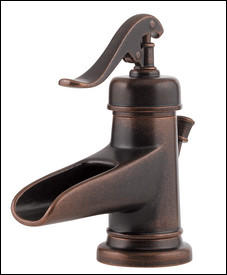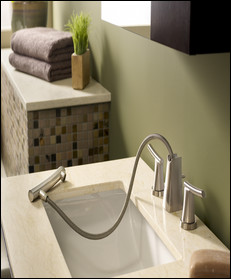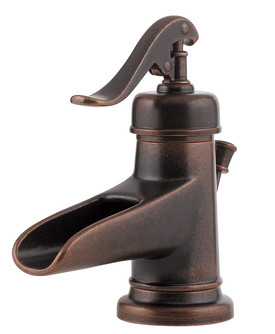Turning water on has never been this fun. Nor has it ever been so easy being green. Faucet makers have developed new designs that save water but won’t make you feel as though you’re washing your hands under a trickle. Varying styles can help you create moods ranging from traditional English-inspired looks to simplistic, modern styles with an Asian influence.
In the kitchen, the focus is ergonomics and ease of use. Pot fillers are growing in popularity, but if you don’t have one, perhaps one of the new six-foot pullout sprayers can reach your stove. And in several lines, sprayers have made their way into bathrooms, too.
Here’s a look at some of the new bathroom and kitchen faucets available today.
Water-Savers
Faucets that save water are growing in popularity as manufacturers respond to the EPA’s WaterSense program, which certifies products that meet water-saving standards, similar to the agency’s Energy Star program for saving electricity. (For more information about the program, read “Making Sense of WaterSense.”)
 The Ashfield faucet by Price Pfister has a trough design that reduces water flow without compromising the water experience. |
But don’t worry—you can still get your hands clean while being green. “People told us, ‘I want to help the environment, but I want the pleasure and enjoyment of water,’ ” says Diane Whitmer, brand manager of Price Pfister. “You can get the water experience you want and still save water for the next generation.”
The goal of WaterSense is to cut faucet flow by 30 percent from 2.2 gallons per minute (gpm) to 1.5 gpm. Price Pfister achieved that mark first with its Ashfield trough faucet introduced in early 2006. When WaterSense was announced that same year, Price Pfister knew its trough design—which offers a wider, flatter surface for water to flow—likely would already meet the standard, and it did. Other manufacturers offering WaterSense-certified faucets include Delta, Moen, American Standard, Brizo and Symmons.
Gerber recently received WaterSense certification for its residential and commercial decorative lavatory faucets. Gerber’s WaterSense certified bathroom faucets are now available in the company’s new Logan Square series as well as in the Abigail, Brianne, Wicker Park, Allerton, Maxwell and Pomeroy styles. All of Gerber faucets are also ADA-compliant and available in a wide variety of styles and finishes. To view the entire product line, visit their Web site.
Price Pfister and other manufacturers have achieved the WaterSense standard by engineering special aerators that increase airflow so you don’t notice the reduced water flow. “The aerator actually delivers more water earlier in the cycle when you turn the faucet on,” says Gray Uhl, director of design for American Standard. “We also mix more air with the water to give it a more forceful feel. It still feels like a nice strong flow rate.”
Manufacturers are also retooling existing faucets to meet the guidelines as early as August 2008. You can also make your faucet more energy-efficient by purchasing aerators, such as Price Pfister’s Eco-Pfriendly™ aerator and Moen’s Flow Optimizer Aerator, to help you meet the water-saving standards without replacing your entire faucet. Installation is an easy process. “You take off the end of your spout, unscrew it and screw the new aerator back on,” Whitmer says. “You don’t have to be handy at all.”
Faucets with lower flow rates have mainly not made their way to kitchens because consumers are more likely to be filling pots instead of washing hands. Reducing the water flow on a kitchen faucet means it would simply take longer to fill the same pot.
 Delta’s Pilar kitchen faucet offers a touch on and off water-saving feature. |
But Delta’s new Pilar kitchen faucet, available in September 2008, offers a water-saving feature that was a big hit with company testers. Once you turn the water on, you can simply tap the handle or the spout and the water will turn off. When you’re ready to return to the sink, tap again and the water comes back on at the temperature and pressure you had before.
“Imagine how many times you turn the faucet on and then leave it running while you’re doing chores elsewhere in the kitchen,” says Sam Straub, Delta’s director of product marketing. “From a water-saving perspective, if you make it easy to turn it off, people will do it. Our testers haven’t wanted to give it up.”
And with the ability to turn the faucet on with just a touch of skin, you can use your forearms or elbows and keep your hands free—especially useful when you’re filling a heavy pot with water or your hands are covered in food from cooking.
Mood-Creators
The right faucet can create a mood in your bathroom, which is particularly useful if you’re seeking a peaceful retreat. The latest bathroom faucet designs offer many choices among modern, Asian-inspired, transitional, traditional and creative styles.
You’ll see an Asian influence in bath faucet designs in streamlined, modern faucets. Companies are also responding to consumer wishes for traditional faucets with flair. “The Asian influence is popular because [Asians] are such admirers of water—their culture celebrates water,” says Judy Riley, vice president of design at Moen.
Moen’s Bamboo design started out in its cutting-edge powder room line and became so popular that it made its way to the company’s high-end Showhouse line. “It’s metal, but it has the shape of bamboo,” Riley says.
American Standard’s Green Tea design offers a contemporary look with an Asian influence. “The Asian-inspired designs meet the desire to create the illusion of simplicity,” Uhl says.
The Green Tea faucet offers one fun feature usually seen in kitchens: a pullout hose. “We designed it as a surprise and a delight,” he says. “You can wash hair in the sink. When you’re cleaning, you can reach every corner. People wanted more flexibility, so we took the technology from the kitchen and added it to the bath.”
Symmons’ Asian-influenced faucet is called the Naru for the Japanese word meaning “a sense of calmness.” “Water flows out of the lavatory in a waterfall,” says Jeffrey Reilly, vice president of marketing for Symmons. “The shape, spout and angles are really distinctive.”
 American Standard’s Green Tea bathroom faucet has an Asian-influenced design and a pullout wand spout. |
For more traditional-looking faucets, look toward Symmons’ Oxford Suite, Price Pfister’s Saxton, American Standard’s Copeland, Moen’s Rothbury and Delta’s Victorian. The Oxford Suite, for example, is inspired by the spheres of the buildings in Oxford, England. “The Oxford Suite will appeal to people who are very traditional but who want to try something with a little more flair,” Reilly said.
Ease of Use
In the kitchen, consumers are looking for features that make chores easier. “People want ergonomics,” Whitmer says. “They also want to make life simpler and more enjoyable.” Price Pfister has a pull-down sprayer that comes out six feet versus the standard four feet length. “You can water plants [or] fill pots,” Whitmer says. “You’re not dragging a lot of water across the kitchen.”
Moen offers a faucet wand with an easy grip that you pull straight down instead of twisting. “You grip it as if you’re shaking hands,” Riley says. You can also get a variety of aerator sprays so you can clean your pots as well as rinse your raspberries without crushing them.
Finishes
As for finishes, brass is still popular but the shine is off. Oil-rubbed bronze is big and chrome is making a comeback in more modern designs. “We’re seeing a pickup again for those gold tones but not as shiny,” says Moen Brand Manager Shaun Hardy. Consumers are looking for antique and brushed and antique bronze.
Also popular are oil-rubbed bronze and aged pewter. “We’re offering more variety in materials, making sure we have a wide variety of finishes in all of our products,” Whitmer says. “People like to experiment with different faucet finishes, depending on the finish of their countertops. Chrome and satin nickel continue to be mainstream. Tuscan bronze is increasingly popular. People can change the materials their faucets are made of and the whole kitchen has been revitalized.” You can accessorize your kitchen and bathroom to make them more enjoyable and easier to use with fixtures that have wow power. “The faucets can become like jewelry for your kitchen and bath—the finishing touch,” Riley says.
Credit: Renovate Your World




























